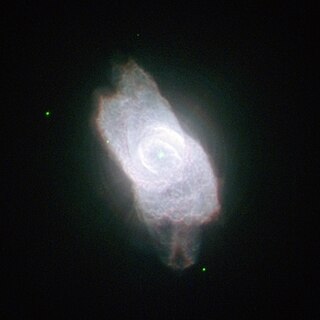Top Qs
Timeline
Chat
Perspective
NGC 6572
Young planetary nebula in the constellation of Ophiuchus From Wikipedia, the free encyclopedia
Remove ads
NGC 6572 is a planetary nebula in the constellation Ophiuchus. It was discovered in 1825 by the German astronomer Friedrich Georg Wilhelm von Struve. According to several sources such as Sky & Telescope, this object received the nicknames Blue Racquetball, Emerald Nebula, Green Nebula, and Turquoise Orb.[citation needed] At magnitude 8.1, NGC 6572 is easily bright enough to make it an appealing target for amateur astronomers with telescopes. At low magnification, it will appear to be just a colored star, but higher magnification will reveal its shape.
This article needs additional citations for verification. (June 2024) |
NGC 6572 is a relatively young nebula, and began to shed its gases a few thousand years ago. Because of this, the material is still quite concentrated, which explains its abnormal brightness. The envelope of gas is currently racing out into space at a speed of around 15 kilometres per second. As it becomes more diffuse, it will dim. Its structure consists of two bipolar shells that are slightly misaligned from each other's axes, as well as a toroidal waist.[2]
The central star of the planetary nebula has a spectral type of Of-WR(H).[4] The central star has an effective temperature of 68,000 K and a luminosity about 5,700 times that of the Sun.[2]
Remove ads
References
External links
Wikiwand - on
Seamless Wikipedia browsing. On steroids.
Remove ads

